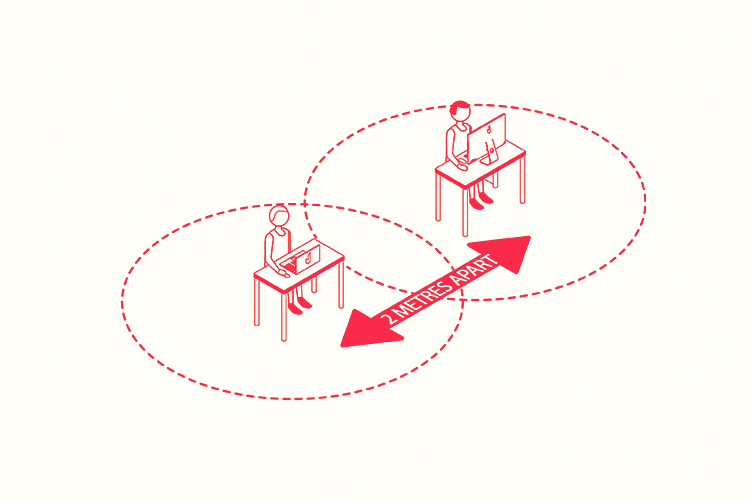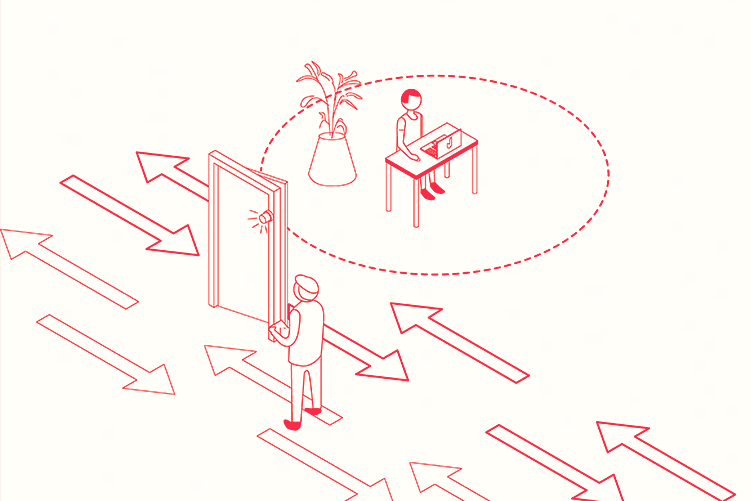The new workplace
It's hard to imagine as we sit in our makeshift home offices, that relatively soon we will need to return to our workplaces.
As office designers, the question of how will we return to work and what this will look like has been intriguing us.
We have been designing office spaces for the last 10 years centered around the ethos of social interaction to encourage serendipitous meetings and enable close collaboration. Large open plan works with reduced desk sizes which allow for larger informal social spaces where everyone eats and meets together.
Clearly this design model sits at odds with the current requirements for social distancing which may well need to continue in some form for months if not years.
A paper, published in the journal Science, concludes that in the absence of a vaccine or effective treatment Coronavirus distancing may need to continue until 2022.
In the short term we anticipate facilities managers will need to implement some immediate measures to adapt their workspaces and allow staff back to work safely.
The long term challenge for designers will be how best to adapt to these new parameters without discarding all the positive attributes of the workspace that we have collectively been striving for.
Whilst homeworking via video conferencing has proven to be very effective, it has not stopped the need for real analogue style human contact. The office as a place to meet in real time will endure.
A paper by Nicolas Bloom, a Stanford economist revealed that working from home during a nine-month period in a controlled experiment led to a 13 percent increase in performance.
Importantly, employees were asked to work from home four days a week and come into the office every fifth day.
In-person collaboration is necessary for creativity and innovation, Bloom says. His research has shown that face-to-face meetings are essential for developing new ideas and keeping staff motivated and focused. The office is still vital to a company's development and innovation.
For now, we need to assist in making the office as safe a place as possible and an effective resilient, adaptable and positive instrument for the future.
Whilst we can't realistically create a contagion free office, employers can and should take as many steps as they can to minimise spread and encourage people back once restrictions have been lifted.
Short term, it's about creating a space that makes people mindful of their interactions and helps people adapt their ingrained habits to protect themselves and their colleagues as much as possible.
Long term our feeling is to dare to think quite optimistically about the future of workspace. We have adapted and survived other epidemics and ultimately come out stronger and more resilient.
The cholera outbreak in London in the 1850s led to implementation of the drinking water and sewage system. leading to a sanitary reform movement.
This enforced global homeworking experiment has already fast forwarded some really positive work life changes thanks to video conferencing and reduced commuting.
Rather than this being the death knell of the physical office we are excited to be part of shaping the future workspace.
We will be able to work together in real life again but we know this will look completely different from the office we left a mere few weeks ago.
With that in mind we have put together some thoughts and ideas for how the current workspace could be adapted based on our own projections and some learnings from those countries already back in the office.
Densification
The new office landscape will need to see a radical reduction in densification of the office.
In China where some have returned to work, companies are running in rotational shifts, to keep the number of people in an office at once to a minimum.
The ratio of 50:50 seems to allow a realistic density adjustment with teams split week on week off.
A lower density on the floor plate can allow for desks to be placed at the current recommended measurement for safe social distancing, with graphics and floor finishes to clearly indicate the 2 meter distance.
On bench desking, seating can be configured to leave larger gaps ideally without people sitting opposite one another.
Co-working spaces
Everything that’s been great about co-working spaces to date now raises questions about keeping employees safe.
Some employers are already considering a move to independent premises. Either a standalone HQ or a series of distributed hubs.
Taking remote working into account could allow for a much smaller footprint of real estate than previously required and allows a level of control and risk management not possible in traditional co-work scenarios.
Partitions
On most bench desking there is often a central partition to aid privacy and acoustics. It seems inevitable that workers may wish to extend the scope of these partitions and potentially add additional side barriers.
Once again we've seen this trend happening in restaurants that have reopened in China. With perspex partitions protecting diners from one another.
This segregating of the open plan office was already a trend mainly centered around need for better acoustic privacy and it feels natural that people will want to segregate themselves further.
Video conferencing
People who were even a month ago unfamiliar with video conferencing are now effectively using it as a tool to connect with their colleagues.
With the return to the workplace, even more opportunities for the office side of the call should be implemented where possible to allow a blurring of wether you are physically in the office building or elsewhere.
Adapting / dividing larger meeting rooms into zoom rooms and standalone zoom pods and booths should be considered.
Presenteeism
Fingers crossed this will finally start to become a thing of the past and the days of leaving your coat on the back of your chair are over.
Its clear employers will have to trust staff further to get their work done wherever they are, but the evidence starting to come across is that for many firms, productivity has gone up rather than down during lockdown. Once schools are operational again this should increase further!
Movement
Companies will need to orchestrate movement though the building. Using examples from the healthcare sector.
Arrows on the floor and clear signage can indicate a single direction of travel along corridors. Stairwells should be assigned where possible for up or down travel.
Surfaces
With 80% of infectious diseases transmitted by touching contaminated surfaces, one study found that SARS-CoV-2 could remain viable on surfaces such as cardboard for up to 24 hours, and on plastic and steel for 2 to 3 days. Therefore a touch free environment will become the standard to aspire to.
Arjun Kaicker who heads up analytics and insights at Zaha Hadid Architects has already started implementing ‘contactless pathways’ for the new Bee’ah waste management company in Sharjah, UAE
Their employees will rarely have to touch a surface. Lifts can be called from a smartphone, avoiding the need to press a button both outside and in, while office doors will open automatically using motion sensors and facial recognition.
Ventilation and fresh air
Improved ventilation is critical, in our experience office buildings are poorly ventilated. Most office HVAC systems don’t bring much fresh air. Instead, they recirculate what’s already inside which is undesirable at the best of times.
Employees will rightly start to demand a comparable level of safe air quality to their home office to justify them coming back into the office.
A reduced daily floorplate capacity will go some way to helping this short term but investing in higher quality clean air will jump in priority.
--------------------------------------------------------------------------------
We hope to have helped get you thinking about your return to the workplace.
Feel free to get in touch if there is anything we can help you with from space planning to practical implementation.
Jackdaw are a practical bunch and are here to help.



